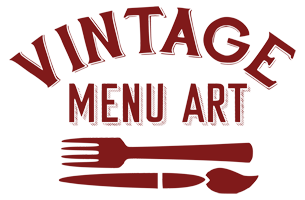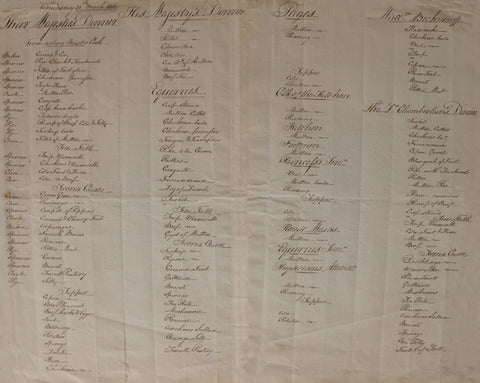King George III & Their Majesties' Dinner, 31st March 1813
This is a rare working document, dated 1813, during the reign of King George III in England. Entitled Their Majesties Dinner, the original is written in ink on hand-made paper.
It shows the dishes that were to be served to the various members of the Royal Household. “Their Majesties” refers to the King’s spouse Queen Charlotte and the couple’s 15 children. There were no written menus during this time, but the Master of the King’s household would make a note of the dishes that were to be served to the Monarch and his entourage every evening. The dinners were à la Française. Many dishes were placed on the table at once, spread over two courses, plus dessert. Master cooks, at the top of the kitchen hierarchy, cooked the most complicated and prestigious dishes (éntrées in the first course and entremêts in the second), and the yeomen or junior servants cooked the simpler ones.
This document would have been used to record which chefs were cooking for each group. Later, it would have been annotated and written up in a kitchen ledger.
It is a fascinating insight into the extravagance and the hierarchy of the Royal household. Equerries – officers who attended the King and Queen – ate rather well in comparison to Pages – lower servants – who were to be served mutton and pudding. Maids just got mutton.
Born in 1738, King George III was a diligent Monarch who suffered from recurring bouts of madness during his 59-year reign. He had a psychiatric illness that resulted in manic episodes in which he talked so incessantly that foam ran out of his mouth, and he suffered convulsions.
He was also known as the King who “lost “America. When he raised taxes on the American colonies, taxing tea, stamps and paper, it led to the incident known as the Boston Tea Party and the start of the American Revolutionary War. In 1776 America declared independence and this took an even greater toll on the King’s health. Under intense political pressure at home, he suffered longer and more frequently occurring bouts of illness and he withdrew from daily business to recuperate out of the public eye at Kew Palace near Richmond.
This menu is dated during this period and it shows the food that was specially prepared for King George – it includes mutton, cheesecakes, potatoes and beef tea.
Attended by his devoted wife and a team of doctors to the very end, the increasingly mentally disturbed King George died in 1820.
With thanks to food historian Annie Gray and The British Library for information on this kitchen document.
Courtesy Lou Greenstein.
We make our prints with archival-quality fine art paper, using professional pigment inks. Properly framed or stored, our prints will last 70+ years without fading or discolouring.
All our prints up to A2 size are made in-house in the UK. For larger prints, we work with the best commercial giclée printers in the UK. Learn more about our printing process, borders and custom orders here.

